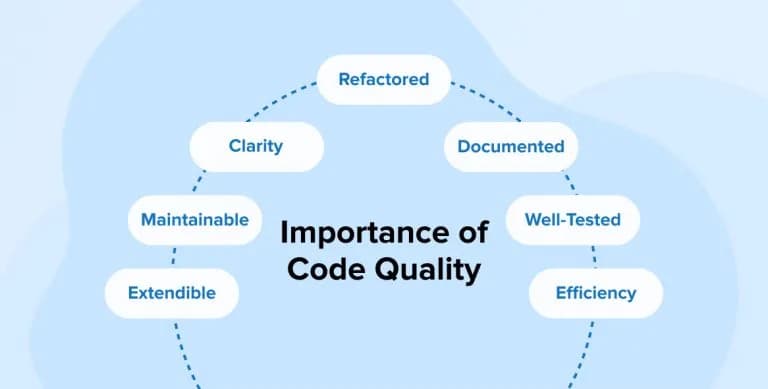1. Establish Coding Standards
Why Coding Standards Matter
Coding standards help maintain consistency, improve readability, and reduce errors. Without clear guidelines, developers might write code in varying styles, leading to confusion and inefficiencies.
Best Practices
-
Follow industry standards like Google’s JavaScript Style Guide, PEP 8 (Python), or Airbnb’s React Guidelines.
-
Use consistent naming conventions for variables, functions, and classes.
-
Enforce indentation and formatting rules using Prettier, ESLint, or Black (Python).
-
Adopt meaningful code comments and documentation to improve maintainability.
2. Use Version Control Effectively
Why Version Control is Important
Version control allows teams to track changes, collaborate efficiently, and revert to previous versions if needed. Git is the most widely used version control system.
Best Practices
-
Use feature branches to keep the main branch clean.
-
Write descriptive commit messages (e.g., "Fixed authentication bug in login API").
-
Implement code reviews before merging changes.
-
Automate versioning using tools like Semantic Versioning (SemVer).
3. Conduct Code Reviews
Why Code Reviews Are Essential
Code reviews help identify bugs, improve security, and share knowledge among team members.
Best Practices
-
Use pull requests (PRs) for every change.
-
Follow a structured review checklist:
-
Is the code well-structured and modular?
-
Does it follow established coding standards?
-
Are there any potential security vulnerabilities?
-
Are all tests passing?
-
-
Encourage constructive feedback and knowledge sharing.
-
Use automated tools like GitHub Code Review, Crucible, or Gerrit.
4. Implement Automated Testing
Why Automated Testing Matters
Testing ensures that the code works as expected and prevents regressions.
Types of Automated Tests
-
Unit Tests – Test individual functions or components (e.g., using JUnit, Jest, Mocha, PyTest).
-
Integration Tests – Test interactions between components (e.g., Postman, Cypress).
-
End-to-End Tests (E2E) – Simulate real user interactions (e.g., Selenium, Playwright).
-
Performance Tests – Measure application performance (e.g., JMeter, Locust).
Best Practices
-
Use a Test-Driven Development (TDD) approach.
-
Automate test execution in CI/CD pipelines.
-
Maintain high test coverage (80%+ recommended).
5. Implement Continuous Integration & Continuous Deployment (CI/CD)
Why CI/CD is Crucial
CI/CD automates the development workflow, ensuring frequent and reliable releases.
Best Practices
-
Use CI/CD tools like Jenkins, GitHub Actions, GitLab CI/CD, and CircleCI.
-
Automate build, test, and deployment processes.
-
Monitor application health post-deployment using logging and monitoring tools.
-
Rollback automatically if issues are detected.
6. Optimize Code for Performance
Why Performance Optimization Matters
Slow applications lead to poor user experience and scalability issues.
Best Practices
-
Avoid unnecessary loops and computations.
-
Use caching mechanisms like Redis and Memcached.
-
Optimize database queries using indexing and query profiling.
-
Minimize memory leaks and optimize garbage collection.
7. Enforce Security Best Practices
Why Security is Essential
Ignoring security can lead to data breaches, financial losses, and reputational damage.
Best Practices
-
Use OWASP Top 10 security guidelines.
-
Implement input validation to prevent SQL injection and XSS attacks.
-
Use HTTPS and secure authentication mechanisms (OAuth, JWT, MFA).
-
Regularly scan for vulnerabilities using tools like Snyk, SonarQube, and OWASP ZAP.
8. Maintain Clean and Modular Code
Why Clean Code Matters
Messy code leads to technical debt and makes future maintenance difficult.
Best Practices
-
Follow SOLID principles (Single Responsibility, Open/Closed, Liskov, Interface Segregation, Dependency Inversion).
-
Break code into small, reusable functions and components.
-
Avoid hardcoding values; use configuration files or environment variables.
-
Use design patterns like MVC, Factory, Singleton, etc.
9. Monitor and Debug Effectively
Why Monitoring is Critical
Issues in production must be identified and fixed quickly.
Best Practices
-
Use logging frameworks like Log4j (Java), Winston (Node.js), and Serilog (.NET).
-
Implement real-time monitoring using Prometheus, Grafana, Datadog.
-
Set up alerting systems to notify developers of failures.
-
Use debugging tools like Chrome DevTools, Postman, and PyCharm Debugger.
10. Conduct Regular Code Refactoring
Why Refactoring is Important
Refactoring improves code readability, maintainability, and performance.
Best Practices
-
Schedule regular code clean-ups.
-
Use static code analysis tools like SonarQube to detect issues.
-
Break down monolithic codebases into microservices.
-
Optimize legacy code without changing functionality.
Conclusion
Ensuring code quality and reliability is a continuous process that requires a combination of best practices, automation, and a strong development culture. At Black Whale Dev, we emphasize clean, efficient, and maintainable code to build high-performing applications that stand the test of time.
By following these guidelines, development teams can reduce bugs, improve security, and enhance user experience, ultimately leading to more successful software projects.
🚀 Ready to build high-quality software? Contact Black Whale Dev today!
